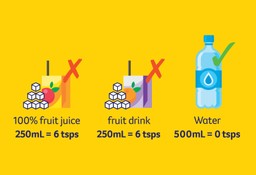What is the difference between fruit juices and fruit drinks? With kids heading back to school this month, we’ve pulled together our top tips to understanding the difference between the two and how to make the best decisions for your kids’ lunch boxes.
Fruit juices and fruit drinks are both made from fruit juice, which makes it confusing when you’re shopping for the best popper to put in your child’s lunchbox.
But a quick glance at the ingredients list and nutrition information panel (NIP) will steer you in the right direction.
To be labelled “fruit juice” in Australia, drinks must contain more than 95 per cent juice. This means, it’s less likely to be a source of added sugar, and more likely to offer some nutrients of benefit, like vitamin c and potassium. It still pays to read the ingredients list though to make sure the juice hasn’t been sweetened.
“Fruit drink” contains a mixture of ingredients such as fruit juice, sugar, fruit puree, fruit juice concentrate, fruit puree concentrate, nectar, reconstituted fruit juice and water—in short, these all mean added sugars.
The tricky thing—even though one may appear better than the other, both fruit juice and fruit drink can contain the same amount of sugar. Our calculations show a 250ml fruit drink or fruit juice popper can contain six or more teaspoons of sugar, which is similar to soft drink.
Why are added sugars bad?
Fruit beverages are packed full of empty kilojoules, which can lead to weight gain, putting children at risk of developing cancer in the future. These drinks also contribute to poor dental health.
What we recommend when choosing a beverage?
At the end of the day, fruit juice and fruit drink can contain the same amount of sugar, so choosing water and packing a piece of whole fruit in the lunchbox is the healthiest option for your children. Water is naturally sugar free and eating a piece of fruit will fill up that hungry tummy because of the dietary fibre content.
The Australian Guide to Healthy Eating recommends only occasional consumption of fruit juice with no added sugar. So, if you do drink fruit juice, limit your intake to ½ cup (125ml) as a serve (note: that’s half a popper!) and choose one with no added sugar in the ingredients list.
Tips for reading nutrition information panels:
- Review the ingredients list to identify any added sugars present. They include sugar, cane sugar (or sucrose), fruit puree, fruit juice concentrate, fruit puree concentrate, nectar, reconstituted fruit juice, fructose, fruit syrup and sugar syrup (e.g., glucose syrup, cane syrup).
- Remember to use the per 100ml column when comparing similar products as the serving size differs between brands. The less sugar per 100ml the better.
- Check the suggested serves, as fruit beverages can contain more than one per bottle. This contributes to the problem with sugary drinks, providing excess sugar and kilojoules.
Download our label reading guide
And remember, water is always best!
Content developed by Mollie van Rhoda, Cancer Council SA Prevention and Advocacy Support Officer and Karissa Deutrom, Cancer Council SA Accredited Practising Dietitian.
Cancer Council SA is currently running Rethink Sugary Drinks, a campaign aimed at educating South Australians on the sugar content in some of our favourite drinks. For more information visit cancersa.org.au/rethink-sugary-drinks/
